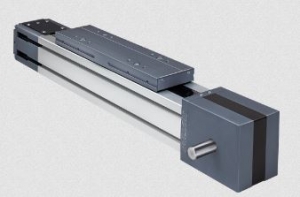Rollon - Selecting Pneumatic Or Rodless Electric Actuators

Rollon - Selecting Pneumatic Or Rodless Electric Actuators
Selecting Pneumatic Or Rodless Electric Actuators
For some automation applications, it can be difficult to decide if a pneumatic or electric motor-driven actuator is best. Obviously, cost can be a big factor when choosing between the two, with pneumatic actuators typically costing less. So why should you pay more for an electric rodless actuator? The answer boils down to higher levels of stiffness, as well as dynamic speed and motor control.
Stiffness
Rod-type pneumatic actuators are driven by air—specifically, compressed air, which is what determines the actuator’s rigidity. Typical pneumatic actuators have a stiffness factor of < 100 N/mm. Rodless electric actuators, on the other hand, use either a belt or ballscrew as their drive medium and are powered by a mechanically coupled motor. For these actuators, the belt or ballscrew determines the actuator’s stiffness. For example, a typical AT10-style, steel-reinforced belt used in quality rodless actuators has a stiffness factor of 7 kN/mm. And ballscrews are even stiffer: a typical 25 mm x 700 mm-long ballscrew has a stiffness factor of 100 kN/mm.
Speed Control
Speed control refers to not only the actuator’s maximum speed, but also its path speed. Having dynamic speed control along the path of travel yields smoother motion. It also allows you to vary the speed, either speeding up or slowing down as your application requires. For the smoothest motion, select an actuator with a high degree of dynamic speed control.
Position Control
Similar to speed control, position control can be static or dynamic. The more control you have over the position of your actuator, the more control you have over motion repeatability and flexibility:
Repeatability is determined by two factors: the stiffness of the drive medium and dynamic position control. If your application requires repeatable positioning, choose an actuator that has a high level of stiffness, as well as the best dynamic position control.
And as for flexibility, dynamic position control allows you to move to multiple positions along the path of travel. That being said, it’s important to keep in mind how many positions your application requires—not just now, but also in the future as your application changes over time. If you need more than two static positions, consider an actuator that provides dynamic position control.
If your application requires smooth motion, multiple position stops, and high repeatability and flexibility, then electric actuators are your best bet.

